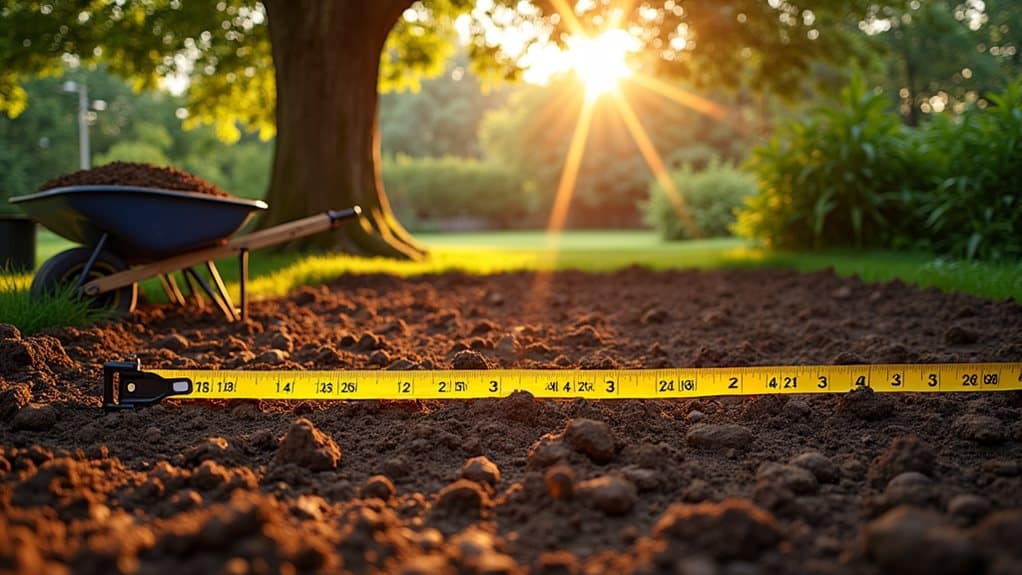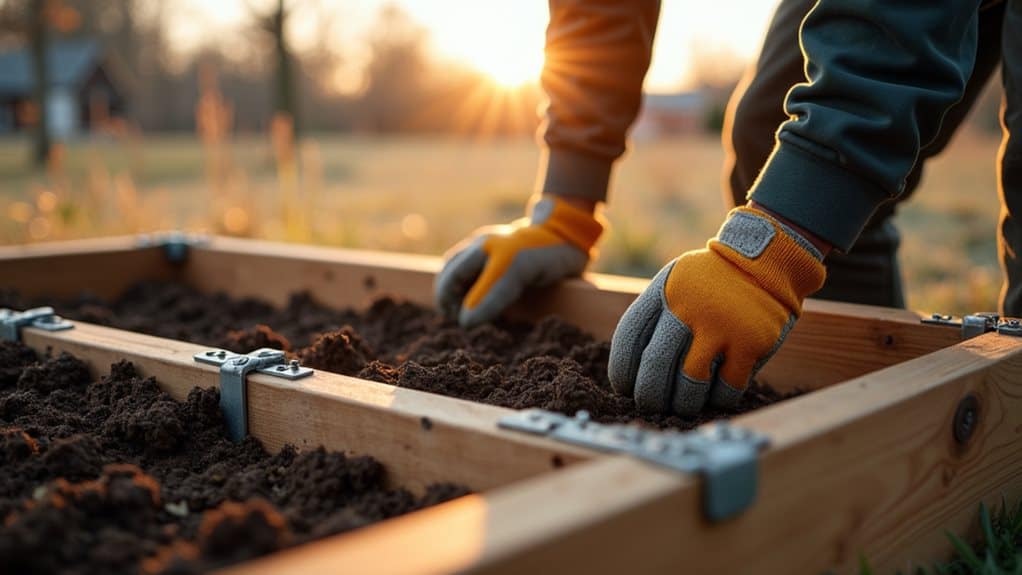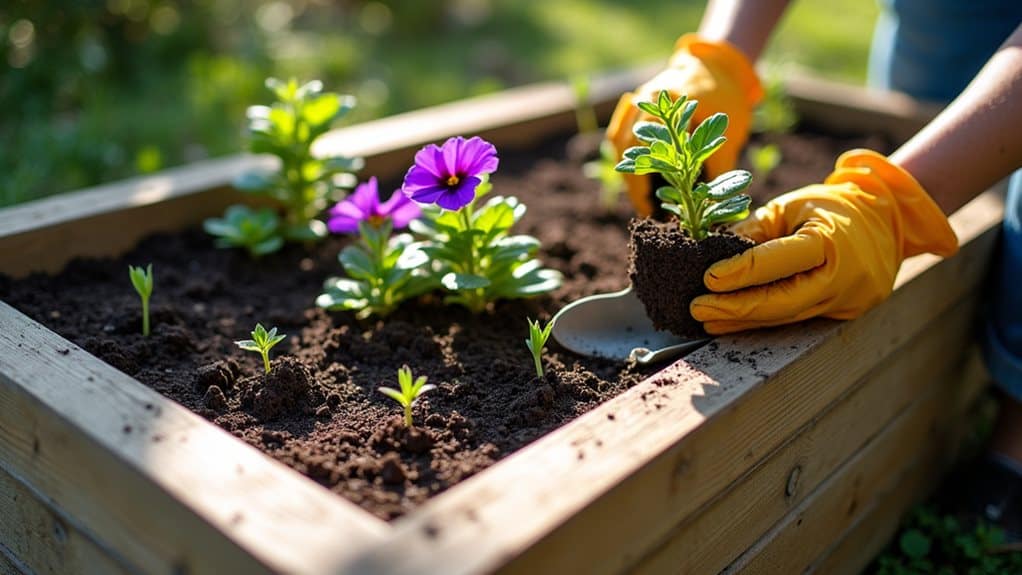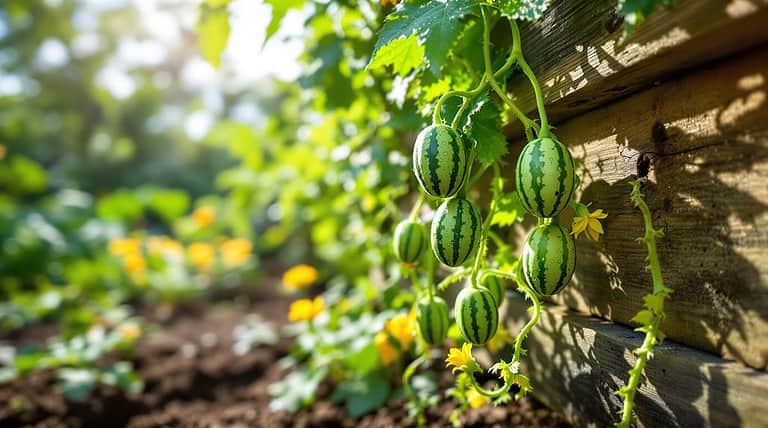Tips for Planting and Building Raised Flower Beds
You’ll want to choose a sunny spot with 6-8 hours of daily sunlight, then build your raised bed using rot-resistant cedar or redwood secured with galvanized screws. Create the perfect soil blend by mixing 60% quality topsoil, 30% compost, and 10% potting mix for nutrient-rich growth that’ll make your flowers absolutely flourish. Don’t forget proper drainage and deep watering techniques – your blooms will thank you later, and there’s so much more to uncover about maximizing your garden’s potential.
Quick Guide
- Choose locations with 6-8 hours of daily sunlight and good drainage, avoiding areas with competing tree roots.
- Build with rot-resistant cedar or redwood using 2-inch thick boards secured with galvanized screws for durability.
- Fill beds with 60% topsoil, 30% compost, and 10% potting mix for optimal nutrient-rich growing conditions.
- Water deeply for about an hour using drip irrigation or soaker hoses to ensure proper moisture penetration.
- Add compost annually in spring and install copper mesh tape to deter pests while maintaining soil health.
Selecting the Perfect Location and Preparing Your Site

When you’re dreaming of creating that perfect raised flower bed, choosing the right location is absolutely essential – it’s like picking the perfect campsite where everything just clicks into place!
You’ll want to scout for spots that get 6-8 hours of sunlight daily, have good drainage, and aren’t competing with those sneaky tree roots for nutrients. Additionally, understanding your growing zone can help you select flowers that will thrive in your specific climate. Don’t forget to leave plenty of room around your beds so your flowers have adequate space to spread out and reach their full gorgeous potential without getting cramped.
Choosing Materials and Construction Techniques
Building your raised flower bed is like constructing the perfect base camp for your garden adventure – you’ll want materials that can handle whatever Mother Nature throws at them while keeping your beautiful blooms happy and thriving!
Choose rot-resistant woods like cedar or redwood, use 2-inch thick boards, and secure everything with galvanized screws for lasting durability. Consider applying a non-toxic wood sealer before assembly to extend the life of your raised bed even further. Additionally, fill your raised bed with topsoil to promote vigorous root growth and ensure your plants have the nutrients they need to thrive.
Creating the Ideal Soil Mix for Optimal Growth

Your raised flower bed’s success depends entirely on creating a soil mix that’s like a five-star hotel for your plants’ roots, complete with perfect drainage, rich nutrients, and just the right texture to keep them happy all season long.
You’ll want to focus on three essential components that work together like a well-oiled camping trio – quality topsoil for structure, coarse sand for drainage, and nutrient-rich compost for feeding your flowers.
Getting the mixing ratios right isn’t rocket science, but it does require some attention to detail, proper preparation steps, and maybe a little trial and error to achieve that perfect soil blend that’ll make your neighbors wonder what your secret is! Additionally, remember to apply amendments annually to ensure your plants have the nutrients they need throughout the growing season.
Essential Soil Components
Although creating the perfect soil mix might seem as complex as packing for a week-long camping trip (trust me, I’ve forgotten essential gear more times than I’d like to admit!), understanding the four fundamental soil particles will change your raised flower beds into thriving garden masterpieces.
You’ll need clay for root stability, sand for drainage, silt for nutrients, and organic matter for texture.
Proper Mixing Ratios
When you’re ready to create that perfect soil blend, think of it like preparing the ultimate trail mix for a backpacking excursion—each ingredient serves a specific purpose, and getting the proportions just right makes all the difference between a successful trek and a disappointing one!
Start with 60% topsoil, 30% compost, and 10% potting mix for fantastic results.
Soil Preparation Steps
Now that you’ve got your mixing ratios down pat, it’s time to roll up your sleeves and actually create this garden gold—and trust me, proper soil preparation is where the magic really happens!
Start by clearing existing vegetation, then test your soil’s pH levels before loosening that native earth at least six inches deep for ideal root penetration.
Plant Selection and Proper Planting Methods

Since you’ve got your raised bed ready to go, it’s time to plunge into the exciting world of plant selection – and trust me, this is where the magic really happens!
Choose climate-compatible flowers like marigolds, petunias, and snapdragons for stunning color, then plant them at proper spacing, water immediately, and add mulch for success.
Essential Watering and Fertilizing Practices
Once you’ve got your beautiful raised flower bed planted and ready to flourish, you’ll need to master the art of proper watering and feeding to keep those blooms looking absolutely spectacular throughout the growing season.
Think of it like preparing meals for a camping trip – you wouldn’t just toss some random snacks in a backpack and hope for the best, would you?
Instead, you’ll want to learn deep watering techniques that reach those hungry roots, uncover how organic fertilizers can work magic on your soil (trust me, I’ve seen wilted plants change into garden superstars overnight!), and create seasonal feeding schedules that’ll have your neighbors wondering what your secret gardening weapon is.
Deep Watering Techniques
Three key principles will convert your raised bed watering from a daily chore into a strategic gardening technique that produces stronger, more resilient plants.
First, you’ll water slowly for about an hour, letting moisture penetrate deep into the soil rather than creating surface puddles.
Second, you’ll target the root zone directly using drip irrigation or soaker hoses.
Organic Fertilizer Applications
While chemical fertilizers might give you that instant green-up that looks impressive for about five minutes, organic fertilizers work like a slow-cooked meal for your flowers—they take their sweet time but deliver incredible, long-lasting results that’ll have your neighbors peeking over the fence wondering what your secret is.
Mix compost and worm castings into your soil’s top six inches for steady nutrition.
Seasonal Feeding Schedules
Your flower beds are basically living on a seasonal meal plan, and just like you wouldn’t eat the same breakfast burrito every single day for a year (though let’s be honest, some of us have tried), your plants need different feeding schedules depending on what Mother Nature’s throwing at them.
Spring gets balanced fertilizers, summer needs regular feeding, fall requires gentle compost additions, and winter means basically no fertilizing at all.
Pest Management and Disease Prevention
Since raised flower beds create the perfect little ecosystem for your blooms to thrive, they can also become attractive real estate for unwanted pests and diseases that’d love nothing more than to crash your garden party.
You’ll want to install copper mesh tape around your bed’s perimeter, which deters slugs and snails effectively by creating an uncomfortable barrier they simply won’t cross.
Seasonal Adjustments and Climate Considerations

Just as you’d pack different gear for a summer camping trip versus a winter mountain excursion, your raised flower beds need seasonal adjustments to keep those blooms happy year-round!
Position beds south-facing in spring for maximum warming, then orient east-west during summer’s blazing heat.
You’ll want cool-season crops like lettuce early, switching to heat-lovers later.
Long-term Maintenance and Soil Health
While your raised flower beds might look like they’re thriving on autopilot, think of long-term soil health like maintaining your favorite camping gear – it needs regular attention, or you’ll find yourself with a soggy sleeping bag when you need it most!
Add compost annually each spring, test your soil regularly, and mulch consistently to keep those beneficial microbes happy and working.
Wrapping Up
You’ve got all the tools now to create stunning raised flower beds that’ll make your neighbors seriously jealous! Remember, gardening’s like camping – it’s all about preparation, patience, and enjoying the adventure, and trust me, there’s nothing quite like watching your first blooms pop up after all that hard work. So grab your gloves, get those hands dirty, and start building the garden of your dreams today!






